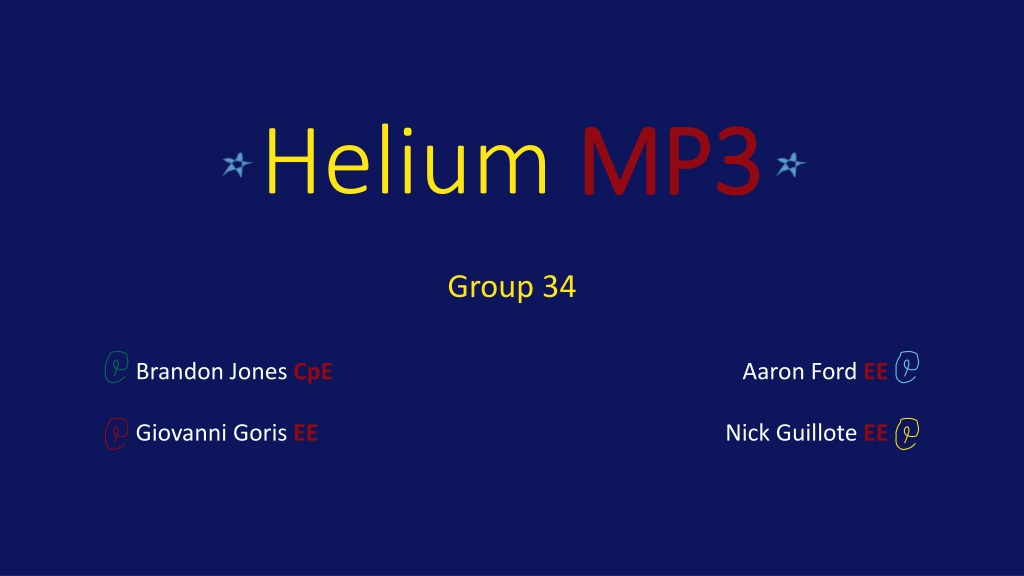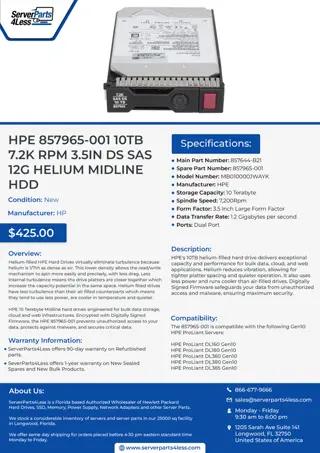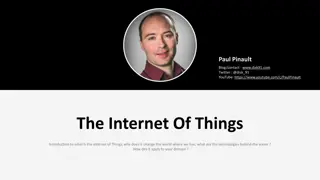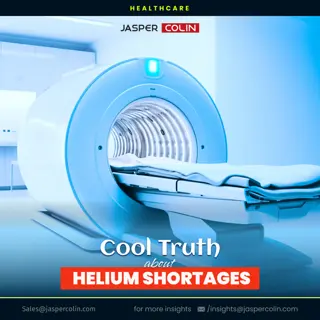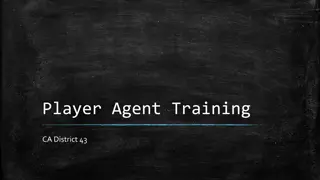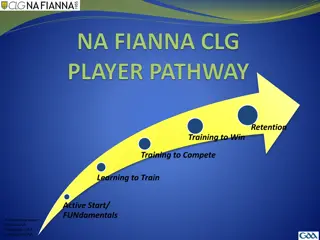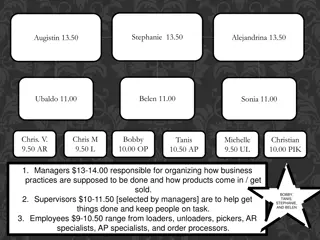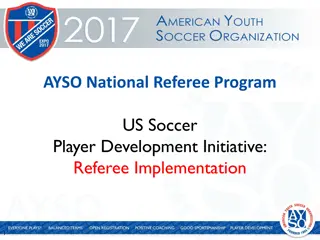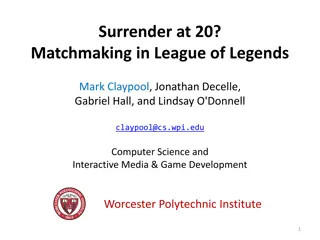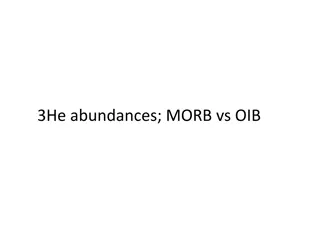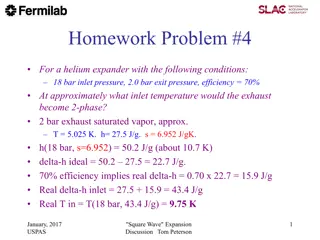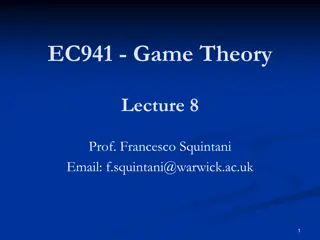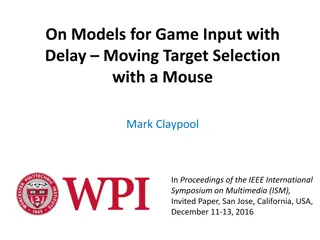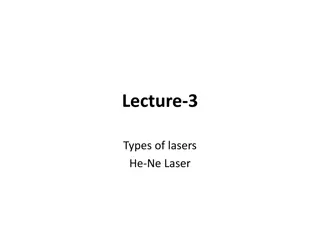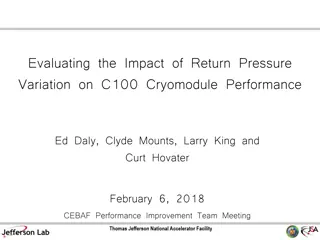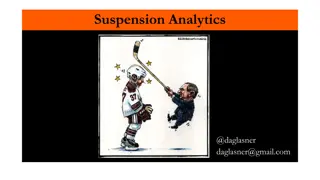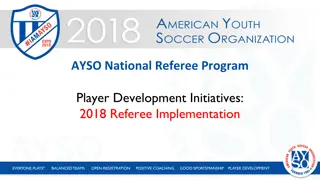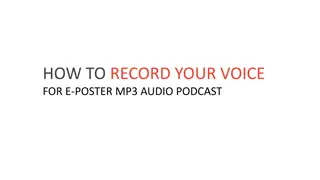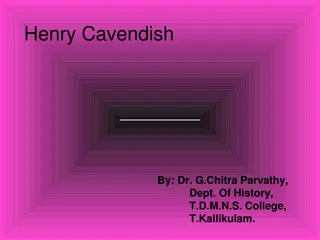Helium MP3 Player Project Overview
This project aims to create a standalone MP3 player with internet connectivity and graphic equalization, incorporating innovative algorithms to personalize user listening experiences based on preferences, time of day, weather, and new songs. The primary device will decode audio files, adjust volume frequencies, store data, identify users with RFID tags, connect to the internet, generate playlists, and communicate with nearby devices, supported by a secondary RFID scanner device and external database.
Download Presentation

Please find below an Image/Link to download the presentation.
The content on the website is provided AS IS for your information and personal use only. It may not be sold, licensed, or shared on other websites without obtaining consent from the author. Download presentation by click this link. If you encounter any issues during the download, it is possible that the publisher has removed the file from their server.
E N D
Presentation Transcript
Helium MP3 MP3 Group 34 Brandon Jones CpE Aaron Ford EE Giovanni Goris EE Nick Guillote EE
Goals To create a standalone MP3 player With internet connectivity With graphic equalization To develop an algorithm for determining users listening preferences For time of day For weather For new songs To develop a mobile app For tracking preferences For control
Objectives primary The device will be able to: Decode .mp3 audio files Adjust the gain (volume) of various frequencies Store audio files, playlists, and user preferences on itself Identify nearby users carrying a RFID tag Connect to the internet Query a database Determine its location Determine the weather at its location Generate playlists based on user preferences (smart playlists) Determine the time of day Communicate wirelessly with nearby mobile devices
Specifications overview The project will consist of two devices: the first, a standalone mp3 player; the second an RFID scanner. The devices are separated so that the mp3 player s location is not limited to locations convenient to the RFID scanner, which has a low range. The first device will now be referred to as the Primary Deviceand the second device will now be referred to as the Secondary Device. The project will also make use of an external database, now referred to as the Server.
Specifications part one Current Objectives Minimum Desired .mp3 Audio files playable .mp3 .mp3, .wav, .wma 10cm (the typical maximum range for NFC) 10m + (the length of a typical living room) < 10 cm RFID read distance 10 Graphic EQ Band Count 5 bands 10+ bands 12 GB Total On-Device Storage 1 GB 10 GB 15,000+ songs On Device Song Storage 50 songs (~500 MB) 1000 songs (~1 GB) 175,000+ songs External Song Storage 1000 songs (~1 GB) 1000+ songs
Primary MCU Beagle Bone Black Options Beagle Bone Black ~ $55 Lots of pins! Raspberry Pi ~ $30 Fruit? Edison ~ $70 Didn t he crash a train? Arduino ~ $25 Not enough pins
Mp3 decoding VS1011 Options Hardware (an mp3 decoder chip) Software VS1011 Decodes MP3 Full 320 Kbit/s with 12 MHz external clock Stereo Output Low power operation Operates with single 12 - 13 MHz or 24 - 26 MHz external clock
Equalizer 10 Band Graphic Equalizer Constant Q factor of 2 Circuit is comprised of 4 main stages Input Stage Filter Stage Boost Stage Cut Stage
Quality Factor ?0 ?= ?0 ? = ?2 ?1 ?0 ?1 ?2 31 Hz 63 Hz 125 Hz 250 Hz 500 Hz 1 kHz 2 kHz 4 kHz 8 kHz 16 kHz 22 Hz 44 Hz 88 Hz 177 Hz 354 Hz 707 Hz 1.414 kHz 2.828 kHz 5.657 kHz 11.314 kHz 44 Hz 89 Hz 177 Hz 354 Hz 707 Hz 1.414 kHz 2.828 kHz 5.657 kHz 11.314 kHz 22.627 kHz
Importance of Constant Q Factor Non-constant Q factor Constant Q factor
Input Stage First op-amp inverts the voltage Second op-amp determines how much gain can be applied Feeds into the filter stage
Filter Stage Comprised of 10 Multiple Feedback Bandpass Filters 10 different center frequencies Covers the entire frequency range Each filter feeds into a potentiometer
Boost and Cut Stage Boost stage activated by the high end of the potentiometer Cut stage activated by the low end of the potentiometer
Speaker Human audible range is 20 Hz to 20 kHz 4 main factors to consider Frequency range Power Volume Cost Speakers considered cover 200 Hz 20 kHz 20 Hz 200 Hz is barely audible
Speaker Options Peerless PMT30N18AL04- 04 19mm (3/4 ) Full Range 250 Hz 20 kHz Peerless TC5FB00-04 1.5" Full Range Paper Cone 200 Hz 20 kHz Peerless TC7FD00-04 2.5 Full Range 4 ohm 130 Hz 20 kHz Product Range Power 1.5 W 5 W 20 W Volume 78 dB 80.1 dB 82.4 dB Cost $9.15 $9.75 $9.85 All have similar cost and frequency range Power and volume became deciding factors 2 dB gap between each option Ultimately, the power was the most important
Power Regulation voltages needed Voltage Current VS1011 -0.3 to 3.6V for Analog and Digital Positive Supply (+,-) 50 mA Equalizer/Amplification (+,-) 10V Beaglebone 5V Up to 1 A MSP430 5V 0.6 mA
Power Regulation voltage regulators * Courtesy of TI
Secondary MCU msp430 The MSP430g2553 is a low power device that can accomplish all the requirements for the RFID. Will use SPI and UART to communicate with the transceiver. Plenty of example codes for each section of the programming There is plenty of support for this product. TI E2E community 43oh.com Simple modifications of the code needed for the project.
RFID Scanner TRF7907A Supports NFC along with different reader protocols. ISO 14443 ISO 15693 ISO 18000-3 ISO 18092 Support from TI There plenty of code samples for this device Low power consumption 100-200 mW
Software Overview Most of the software on the Primary device was written in Java (for readability), with portions developed using Python (for ease of development). The content server is written in Python. NOIP is used to handle DDNS The mobile app will be developed using jQuery.
Three threads: Init (main) Communication AudioOutput (in the MediaController)
Communication receives requests from above and processes them in the order received. Reponses are generated for every request and stored in a queue. HeliumServer: The content server; sd2helium2.ddns.net Location: Skyhook WPS API WeatherService: Open Weather Map TimeService: NIST Internet Time Servers
Users will have a master playlist containing all the songs that they own. For each song, a user s listening habits will be tracked and parameterized for the song selection algorithm (executed in each user s SongSelecter)
Song Selection The goal: to circumvent the need for a user to create playlists or indicate what song they would like to hear Learn a user s listening preferences based on: Time of day Weather Time since last played Play density for custom tags created by the user; such as: Female Vocals Artsy Punk
Song Selection The Algorithm Setup: For every song listened to and skipped, record when and under what conditions; Plays and Force Plays (willfully selected songs) are recorded separately; Modify counts over time: PC = PTW + (PLW)/2 Not implemented: bi-/tri-grams (with Good-Turing Smoothing) *Pc = playcount, TW = this week, LW = last week To Select: For each song calculate a play weight based on the current conditions SW =
Storage All songs will be stored on the main server and a subset of songs will be stored on the primary device. All user data will be stored on both the main server AND on the primary device. A simple database will be made from scratch (using Python) on the main server. The group probably won t need all of the features that a MySQL database offers
Work Distribution X: primary Brandon Giovanni Aaron Nick Management X X: secondary Algorithms X PD: Primary Device Control (PD) X Control (SD) X SD: Secondary device Mobile App x X RFID X Equalizer X Power x X PCB X x
Original Budget Unit Item Details Cost MCU BeagleBone Black $55.00 Memory Included with MCU BeagleBone Black includes 512 MB of memory. - MP3 Decoder VS1011 http://www.vlsi.fi/en/products/vs1011.html $20.64 RFID Scanner TBD For detecting people $600 WiFi Card TBD For connecting to the internet $20 A/D converter Team will build For converting analog audio input to digital audio input - Amplifier TBD For amplifying analog audio output TBD Equalizer Team will build A graphic equalizer with 6+ bands - Microphone TBD Accepts voice input for implementing voice commands $20 Server Space TBD For external storage and processing Already acquired Additional Parts and Emergency funds Various; TBD $71.56 Tools Estimated Total Cost = $787.20
Current Budget Item Price /unit Unit Total Item Price/unit Unit Total RFID System MCU system Trf7970aBP $20.00 1 $20.00 Beagle bone $55.00 1 $55.00 LCD Module $10.99 1 $10.99 DS touchscreen $12.00 1 $12.00 MSP430f5529 $7.00 2 Free Micro SD card $16.00 1 $16.00 MSP430g2553 $10.20 2 $10.20 RN4020 $10.61 1 $10.61 Bluetooth $10.61 1 $10.61 Amplifier and audio system Miscellenaous 10k potentiometer $3.97 2 $7.94 Resistors $9.64 1 $9.64 Digital potentiometer $0.61 11 $6.72 Capacitors $20.00 1 $20.00 Tl084 $7.43 1 $7.43 CD74HC4016 $1.40 5 $7.00 LM339 $11.48 1 $11.48 PCB VS1011 $20.64 1 $20.64 Total $236.26
Issues WE ARE BEHIND! Lack of decisiveness Stuck waiting on critical parts Scheduling issues Distribution of work? We are under budget though
